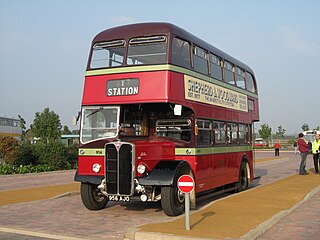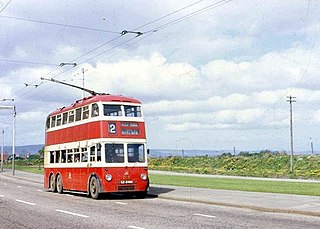Related Research Articles

A bus is a public transport road vehicle designed to carry significantly more passengers than the average cars or vans. Buses can have a capacity as high as 300 passengers, although the average bus usually carries between 30 to 100. The most common type is the single-deck rigid bus, with double-decker and articulated buses carrying larger loads, and midibuses and minibuses carrying smaller loads. Coaches are used for longer-distance services. Many types of buses, such as city transit buses and inter-city coaches, charge a fare. Other types, such as elementary or secondary school buses or shuttle buses within a post-secondary education campus, are free. In many jurisdictions, bus drivers require a special large vehicle licence above and beyond a regular driving licence.

The AEC Routemaster is a front-engined double-decker bus that was designed by London Transport and built by the Associated Equipment Company (AEC) and Park Royal Vehicles. The first prototype was completed in September 1954 and the last one was delivered in 1968. The layout of the vehicle was conventional for the time, with a half-cab, front-mounted engine and open rear platform, although the coach version was fitted with rear platform doors. Forward entrance vehicles with platform doors were also produced as was a unique front-entrance prototype with the engine mounted transversely at the rear.

London Buses route 11 is a Transport for London contracted bus route in London, England. Running between Fulham Broadway and Liverpool Street, it is operated by London General.

A double-decker bus or double-deck bus is a bus that has two storeys or decks. Double-decker buses are used for mass transport in the United Kingdom, the United States, Europe and Asia, the best-known example being the red London bus, namely the AEC Routemaster.

Associated Equipment Company (AEC) was a British vehicle manufacturer that built buses, motorcoaches and trucks from 1912 until 1979. The name Associated Equipment Company was hardly ever used; instead it traded under the AEC and ACLO brands.
British United Traction (BUT) was a manufacturer of railway equipment and trolleybuses. It was established in 1946 as a joint venture between AEC and Leyland.

Park Royal Vehicles was one of Britain's leading coachbuilders and bus manufacturers, based at Park Royal, Abbey Road, in west London. With origins dating back to 1889, the company also had a Leeds-based subsidiary, Charles H. Roe.

London Buses route 8 is a Transport for London contracted bus route in London, England. Running between Bow Church and Tottenham Court Road station, it is operated by Stagecoach London.
London Buses route 12 is a Transport for London contracted bus route in London, England. Running between Dulwich Library and Oxford Circus, it is operated by London Central.

Selkent is a bus company operating in central and south London and some parts of north-west Kent. It is a subsidiary brand of Stagecoach London and operates services under contract to Transport for London. The brand is not publicly used since 2010 as all buses are branded as Stagecoach, but it exists as a legal entity.

The East Kent Road Car Company Ltd was a bus company formed in 1916 and based in Canterbury, Kent. The company operated bus and coach services in Kent. In 1993 it was one of the first companies to be acquired by the Stagecoach Group, which eventually rebranded the operation as Stagecoach in East Kent, and made it part of the Stagecoach South East bus division.

London Country Bus Services was a bus company that operated in South East England from 1970 until 1986, when it was split up and later sold as part of the bus deregulation programme.

Samuel Ledgard (1874–1952) was a Leeds entrepreneur who became a major West Yorkshire Independent bus operator. Following his death in 1952, his executors continued to operate the Samuel Ledgard bus company until 1967, when it was acquired by the West Yorkshire Road Car Company.

The AEC Regent III was a type of double-decker bus chassis manufactured by AEC.

The AEC Swift was a rear-engined step entrance single-decker bus chassis manufactured by AEC between 1964 and 1980. The chassis design was closely related to the Leyland Panther. It was available in 33-foot (10 m) and 36-foot (11 m) lengths, with an AEC AH505 or AH691 engine.

The AEC Regent V was a front-engined double-decker bus built by the Associated Equipment Company between 1954 and 1969. It was the last version of AEC Regent series double-decker and was the successor to the AEC Regent III.

The Belfast trolleybus system served the city of Belfast, Northern Ireland. It was the only trolleybus system built in Ireland. Opened on 28 March 1938, it gradually replaced the city’s tramway network.

The Reading trolleybus system served the town of Reading in the English county of Berkshire and was owned by Reading Corporation, who had operated an electric tramway since 1901. As there was a need for major refurbishment of the tramway in the 1930s, they decided to replace it with a trolleybus network. The first route was converted on 18 July 1936, and by mid 1939, trolleybuses were running over most of the tramway routes, with the last tram running on 20 May. By the standards of the various now-defunct trolleybus systems in the United Kingdom, the Reading system was a moderately sized one, with a total of four routes, and a maximum fleet of 63 trolleybuses, a size that lasted from 1 December 1950 to 27 March 1952.

The AEC Bridgemaster was a front-engined low-height double-decker bus chassis manufactured by AEC.

The AEC Regal IV was a bus chassis manufactured by AEC.
References
- ↑ AEC's V8 Sabre for high-speed touring Commercial Motor 6 September 1968
- ↑ Companion to Road Passenger Transport History. Walsall: Roads & Road Transport History Association. 2013. p. 32. ISBN 978-0-9552876-3-3.
- ↑ AEC Sabre, Bus Lists on the Web